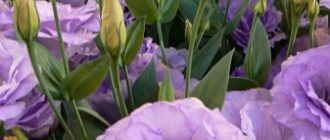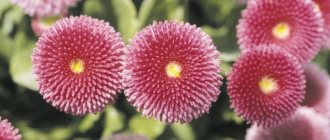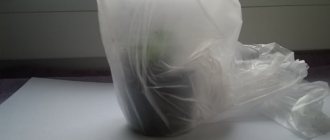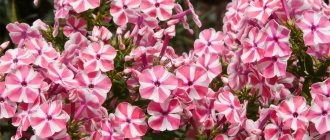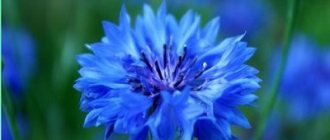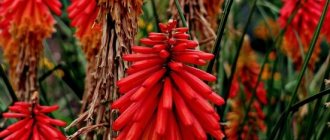What do gerbera flowers look like?
- Gerbera is very similar to chamomile. But unlike the white petals of chamomile, gerbera has a different color
- There are white, scarlet, pink, yellow and other gerberas. Almost all varieties are distinguished by bright colors
- Gerbera belongs to the Aster family, so there are similarities with lush asters
- Low-growing varieties are ideal for growing indoors. However, it is worth noting that the height of the gerbera stem can reach 60 cm
- The diameter of the flowers ranges from 4 to 12 cm
Gerbera indoors
Gerbera varieties
Many varieties of hybrid gerberas have been developed. Let's look at some of them.
Terry gerbera Daisy 'Cartwheel Strawberry Twist'
Gerbera jamesonii
Gerbera Daisy Garvinea Sweet Surprise
Gerbera Apricot
Gerbera Daisy red and white
Gerbera White Ava Maria
Are gerberas perennial or annual?
Important: In open ground, gerberas are grown in greenhouses. Constant changes in climatic conditions are not acceptable for this plant. Indoor gerberas live much longer.
Gerbera can be an annual or perennial plant. If we are talking about open ground, then gerberas can please the eye only for one year - in the summer. In winter, the roots must be dug up and placed in a basement with a suitable temperature. In this case, there should be an earthen lump on the roots. This is the only way the roots can survive.
Indoor gerbera is a perennial plant. The plant will live a long time if you take proper care
Is it possible to root a gerbera from a bouquet?
Nov 15 • Uncategorized • 121 Views • No comments on the post Is it possible to root a gerbera from a bouquet?
Gerberas are large flowers that are similar in appearance to daisies.
They can be of different colors - red, pink, orange, yellow. Gerbera can be double or semi-double. All these varieties differ in the number of petals and size.
Next we will talk about the characteristics of plant propagation. Namely: what are the methods and difficulties encountered during this procedure. And also how to care for this perennial flower.
Gerbera: the meaning of the flower, what it symbolizes, signs
Important: It is generally accepted that every flower means something. For example, carnations are traditionally considered a mourning flower; roses mean love.
Gerbera has a positive meaning:
- Represents joy and lightness
- If a man gives a woman gerberas, we can assume that he is interested in her
- Another meaning of the flower is flirtation, mystery
There are several versions of the origin of the flower:
- The genus was named after the German botanist and physician Traugott Gerber. Traugott Gerber was a researcher of the flora of the Volga region, and also served as director of the botanical garden in Moscow
- The second version of the name comes from the Latin word “herba”, which means grass
- In some English-language sources, gerbera is called “Transvaal daisy”
Varieties of gerbera
If you want to give a gerbera in a pot to your relatives, friends, but at the same time you believe in omens, do not doubt it. Because gerbera represents the best qualities.
Reproduction
Gerbera propagates in three ways: by seeds, by dividing the bush into shoots and by cuttings.
Even in the most favorable indoor conditions, this flower will not be able to look attractive all the time. The time will come when the plant needs rebirth and renewal. This is not difficult to do, especially when you want to save the flower you like. The seed propagation method seems to be simple, but the result may not be pleasing. Gerbera seeds have extremely low germination rates. They should not be stored for more than six months. When purchasing them in a store, no one guarantees when these seeds are collected. Special attention must be paid to this fact.
Propagation by cuttings is used very rarely due to its low efficiency. Sometimes this method of reproduction is chosen at experimental stations.
But one of the most common and frequently used methods is propagation by dividing the bush into parts. This method allows you to make a large number of young plants from one adult plant. After such a procedure, an adult gerbera seems to acquire a second youth and continues to grow and develop.
This method of propagation cannot be carried out during the flowering period. As soon as the plant has bloomed (preferably in the summer), you need to very carefully remove it from the flower pot, lightly shake off the soil and divide it with a knife into as many parts as possible.
There is another option that allows you to leave the gerbera in a pot. The top layer of soil must be removed before the plant trunk appears. Then carefully divide it into two parts with a knife and sprinkle the cut areas with soil. After a short time, both parts will take root, this will be a signal of readiness for their placement in different containers.
- Seeds. They are sown in spring in a light soil mixture.
Pots or boxes are filled with a mixture of leaf soil, peat and fine sand. Scatter the seeds. They are lightly covered with sand on top. The surface is sprayed with a spray bottle. Next you need to create a greenhouse. The container can be covered with glass or a plastic bag. And put it in a warm, bright place. In a week the seedlings will hatch. In the “greenhouse” they can burn, so we remove the shelter. When two or three true leaves are formed, you can dive. Gerberas are transplanted into permanent containers when four to five leaves appear. Young gerbera from seeds blooms in six months to a year. - By dividing the bush. When transplanting, the variety you like is divided into several divisions, each of which should have two or three growing points. Children's roots are slightly trimmed, flowers are removed, and the sections are treated with charcoal. They can be immediately planted in permanent pots. So that the growth point remains on the surface.
- Cuttings. Perhaps the easiest way to propagate gerberas. A cutting with a piece of rhizome and one or two leaves is separated from the mother plant. Plant it in a separate pot filled with moist substrate. And put it in a warm sunny place.
- Gerberas are very good to cut. With their help, beautiful bouquets and floral compositions are formed. They look perfect surrounded by greenery and other flowers. But they are very capricious. And without special techniques they won’t last long.
Gerberas in a pot: how to care, what kind of soil is needed, how often to water?
Experienced gardeners do not see any difficulties in growing indoor gerberas. But if you are new to floriculture, you should know some care tricks.
Watering
- Excessive watering is inappropriate. If water stagnates in the pot, fungal diseases of the plant can develop. Also, excessive watering can lead to yellowing of the leaves.
- Poor watering, in turn, leads to a state of dormancy. Gerbera will stop blooming
- Water the flower along the edge of the pot, as gerberas are prone to fungal diseases
Important: The secret to watering gerberas is to use warm, settled water. The water can be at room temperature, but in no case is it cold. If you water a gerbera with cold water, there will be a difference in air and water temperature, as a result of which the plant will begin to rot.
Care for gerbera at home
Lighting
- A lot of light and not direct sunlight is a prerequisite for the growth and flowering of gerbera
- In the summer, it is advisable to place the flower on the balcony or loggia so that there is access to fresh air.
- In the winter season, when there is very little light, it is advisable to support the gerbera with fluorescent lamps
- The normal temperature for gerberas is 24°
The soil
- The following soil mixture is used: leaf soil with the addition of peat, sphagnum or purified sand
- It is unacceptable to add compost or humus to the mixture.
- Choose magnesium sulfate as a fertilizer; at low temperatures you can fertilize with phosphorus
- Fertilizer concentration should be weak
- There is no need to fertilize gerberas in winter.
When to sow gerbera seeds for seedlings
Gerbera seedlings from seeds at home take quite a long time to develop. From the moment of planting to the beginning of flowering, at least ten months usually pass. Therefore, it is recommended to sow the crop as early as possible so that the plant can bloom already in the current season.
In the Moscow region and the entire central zone, planting at home is carried out during January. In Siberia and the Urals, the procedure can be postponed until the beginning of February. In the southern regions, it is allowed to sow as early as December, shortly before the New Year.
Attention! When planting and growing gerbera from seeds, in any case, it is necessary to use phytolamps. There is too little natural sun in winter for the normal development of seedlings.
Gerbera pot: which one to choose?
We should also talk about a pot for growing gerbera. It is known that it is undesirable to use pots after other plants, as they may contain disease spores. Therefore, you need to replant the gerbera into a new pot.
The pot must meet the following requirements:
- Must be free
- It is necessary to have a tray that will not come into contact with the pot (pallet on a stand)
Important: Although the plant does not like overwatering, a certain humidity must be maintained constantly. The right pot helps in this matter. Place pebbles on a tray and pour water over them. If the tray is not in contact with the pot, the roots will not absorb the water, but it will still be a moist environment.
Useful video
In this video you will learn more about the plant:
Useful materials Below is a list of articles that may be of interest to you:
If you find an error, please select a piece of text and press Ctrl+Enter.
Gerbera is propagated by seeds or by dividing the bush; The peduncle, alas, does not take root. If you really want to, try pollinating the flowers; the seeds ripen in 4-6 weeks; try to create conditions so that the flower stalks do not die (change the water periodically, make a weak fertilizer solution). This is purely theoretical, there was no such practice.
They don’t grow well from seeds either) so just admire the bouquet)
No. It won't work out of a bouquet. and she is very capricious.
those varieties that are in bouquets will NEVER grow here. the seeds will also be low-growing.
Gerberas grown in a greenhouse
gerbera from cuttings is nonsense. You can also try!
Why do indoor gerbera leaves turn yellow and dry: what to do?
Gerbera leaves turn yellow and dry if they are attacked by pests :
- Whitefly . The plant should be treated with a preparation containing permethrin.
- Spider mite . To get rid of it, spray the leaves 2-3 times a day with clean water. If this does not help, you need to use the drug Actellik
Important: Yellowing occurs when overwatering. Reduce watering if your gerbera begins to wilt and turn yellow.
Diseases and pests
The immunity of any plant declines if it is not properly cared for. This is the cause of gerbera diseases and the fact that pests attack it.
Spider mite . The leaves turn yellow and fall off. This happens due to dry air and lack of moisture. To avoid this, it is necessary to regularly ventilate the room and do not forget to water it.- Powdery mildew . Appears when watering with cold water or a sudden change in temperature. When sick, it is necessary to isolate it from other indoor plants.
- Whitefly and aphids . Settles on the underside of leaves and lays eggs. Reproduction occurs very quickly. Occurs as a result of lack of moisture.
- White and gray mold . Appears due to waterlogging. It is recommended to remove the affected leaves and spray the plant with a solution of copper sulfate.
Read more about why gerbera leaves turn yellow and how to deal with it in this material.
Compliance with all care conditions will help you grow gerbera at home without any problems and admire its beautiful flowers on the windowsill or in the garden for a long time.
Gerberas: growing in open ground in the garden, at the dacha
Growing gerberas in open ground is not an easy task. These are annual plants, so they will have to be sown every year. And seed germination will depend on weather conditions. As you know, gerbera needs light and warmth.
When cold weather sets in, you can dig up the roots of the gerberas and try to save them until next year. This is what they do with dahlias, for example. However, gerbera roots need to be stored in a dry place with a ball of earth; they need to be covered with straw and a layer of dry leaves. The temperature at the storage location should be about 8º.
Important: In Africa, gerberas grow on their own, but the climate of Russia and many other countries does not allow gerberas to grow without problems.
Growing in open ground
Types of gerbera with photos
At home and with proper care, indoor gerberas can bloom several times a year. All presented flowers, which are grown on plots and at home, were the result of the selection of two varieties: classic green-leaved and Jameson. And within these species, varieties and varieties are divided according to color, flower size, and doubleness.
Low-growing and compact species are suitable for growing on a windowsill, which include the following varieties:
Festival - characterized by a short stem and large multi-colored flowers.
Aldebaran and Alcor - have small flowers and narrow leaves, often used for industrial cultivation.
Jupiter, Vega, Migar - the flowers have narrow leaves, and the flowers are slightly larger.
Mars – This variety has medium-sized leaves and large flowers.
Gerbera Mix is especially popular among gardeners, not only because of its beauty, but also because of its varied colors. It does not reach large sizes when grown in pots, and also does not require special care.
How a gerbera wakes up and falls asleep, video:
How Gerbera wakes up and falls asleep
Optimal conditions
Due to its rather fragile roots, it is recommended to sow gerbera seedlings immediately in separate cells or cups, although if necessary, it tolerates picking quite well. The seeds can simply be placed on the ground (without deepening), sprinkled on top by 3-5 mm, and then watered generously from a spray bottle with water heated to 40°C. To speed up germination, the container is usually covered with a transparent lid or glass, creating a greenhouse effect, and left in a warm place.
strawberry-seedling-03.jpg
Lighting. As soon as the sprouts appear, the container must be placed on a well-lit windowsill, or under a special lamp. Daylight hours during this period should be at least 12 hours. If sowing is carried out in summer, it is better to choose the eastern or western side, as scorching rays can damage delicate seedlings.
vyrashchivanie-gerber-v-sadu.jpg
Hydration. The gerbera should be watered exclusively with warm water not lower than +22°C, otherwise its roots will gradually rot and growth will slow down. The substrate should be slightly moist all the time, but it is important that the drops do not fall on the rosette where young leaves and buds appear. Adult plants respond well to watering through a tray. There is no need to spray the ground parts.
maxresdefault.jpg
Temperature. These heat-loving flowers often get sick or stop developing if the thermometer drops below +17°C. A temperate climate is suitable for young seedlings at the stage of 2-4 first leaves to slow down the growth of green mass and allow roots to develop, and is also very desirable in summer. During other periods, it is better to keep gerberas at +20...24°C, avoiding sudden temperature changes, drafts and heat. They should also be hidden from direct light in light partial shade, leaving them in the sun only in the morning and evening.
pikirovannye-seyancy-gerbery.jpg
Feeding. Like other indoor flowers, gerbera requires nitrogen fertilizers for active growth of leaves (in March-April) and phosphorus-potassium fertilizers for laying buds (in July-August). Preparations can be applied with watering, approximately 40 days after emergence. Fertilizers must be applied in small doses every 2 weeks, except in winter, when the plant is in hibernation. Manure and other organic matter are not suitable for this crop.
rassada-gerbery.jpg
Growing seedlings at home
It is advisable to rejuvenate gerbera every 4 years, so when growing it, you should master propagation methods: vegetative (dividing the bush and cuttings) or seed. The last method is the most time-consuming and labor-intensive. Flowering of a young plant occurs after 10–11 months.
Landing dates
Sowing of seeds is carried out from February to March. It can also be produced directly after collecting the seed material yourself.
Planting containers and soil
For planting, it is necessary to prepare special small and wide boxes and soil. The soil should be light, loose, nutritious. It can be composed of turf soil (2 parts), leaf soil (1 part), humus (1 part), sand (1 part) or deciduous soil (2 parts), sand (1 part). Soil acidity should be at 5.5–6.5 pH.
After mixing, the substrate must be watered with a solution of potassium permanganate. Before placing it in the planting box, a layer of drainage is placed on the bottom.
Did you know? The organs of the gerbera, like all members of the Asteraceae family, contain coumarin derivatives, a substance that is used in perfumery to impart a sweet, herbaceous-hay, tobacco aroma in 90% of perfume compositions.
Seed preparation
In order to get their own seeds, the plants need to be artificially pollinated in August. After collecting the seeds, they are dried at a temperature of +25...+30°C and cleaned. After this, they are disinfected in a solution of potassium permanganate, and then soaked in warm water for several days and in a growth stimulator for several hours.
Sowing seeds
Seed material is laid out on the surface of moist soil according to a 2x2 pattern. A small layer of soil is poured on top. The box is covered with glass or film.
Further care of seedlings
The box with seeds must be placed in a place where the temperature is maintained at +18...+20°C and bright lighting. Before sprouts hatch, you need to ventilate them daily and regularly moisten the substrate with a spray bottle.
The emergence of seedlings occurs after 1–1.5 weeks. At this time, it is necessary to remove the cover. When 4–5 leaves appear, you should pick them into separate pots.
When do they ripen and how to harvest?
After successful pollination, the seeds of the plant will be ready for collection in a month, as soon as the center of the flower becomes fluffy. The flower is disassembled by hand and the seeds are removed. It is worth remembering that the seeds retain good germination only 6 months from the moment of collection , during which time they need to be planted in the ground. The price depends on the amount of seed in the bag. For example, 25 pcs. - 80 rubles, and 10 pcs. – 0t 22 to 40.
Important : When purchasing, look at the packaging period of the seed material; if it is more than 6 months, you should not buy such seeds, their germination rate is very low.
Brief description of cultivation
- Bloom . It begins in the last weeks of summer and ends in early autumn.
- Illumination . A large amount of bright light is needed, which must be diffused. In the autumn-winter period, the flower often has to be illuminated.
- Temperature regime . During the growing season - approximately 20 degrees, in the cold season - from 14 to 15 degrees (not lower than 12 degrees). During the flowering period, the difference between the air temperature at night and during the day should be about 5 degrees.
- Watering . During the growing season, watering should be moderate; it should be done immediately after the top layer of soil mixture in the pot has dried. With the onset of the dormant period, watering is greatly reduced; at this time, the substrate is moistened only so that it does not dry out completely.
- Air humidity . She must be tall. But it is forbidden to moisten the foliage with a spray bottle; instead, wet pebbles are poured into the tray, and a pot with a flower is placed on it.
- Fertilizer . During the growing season, fertilizing is carried out once every 15 days and a complex mineral fertilizer for flowering indoor plants is used for this. In winter, the plant does not need feeding.
- Rest period . It begins in the second half of the autumn period and ends in the last weeks of winter.
- Transplant . It is carried out only if necessary in the spring. Remember that the rosette cannot be buried in the soil mixture.
- Soil mixture . It should be loose with a pH of 5.5–6.0, and also allow air and water to pass through well. For planting, a purchased soil mixture for asters is suitable, or you can make it yourself by combining sand, leaf soil and peat (1:1:1).
- Reproduction . By division of rhizomes and seed method.
- Harmful insects . Aphids, whiteflies, scale insects and mealybugs.
- Diseases . If you do not care for the gerbera correctly or do not provide it with suitable conditions for growth, then problems may begin with it.
Gerbera indoors

